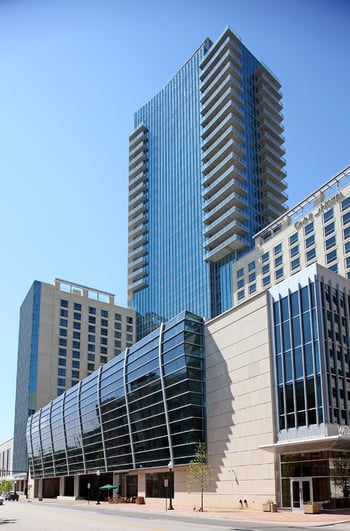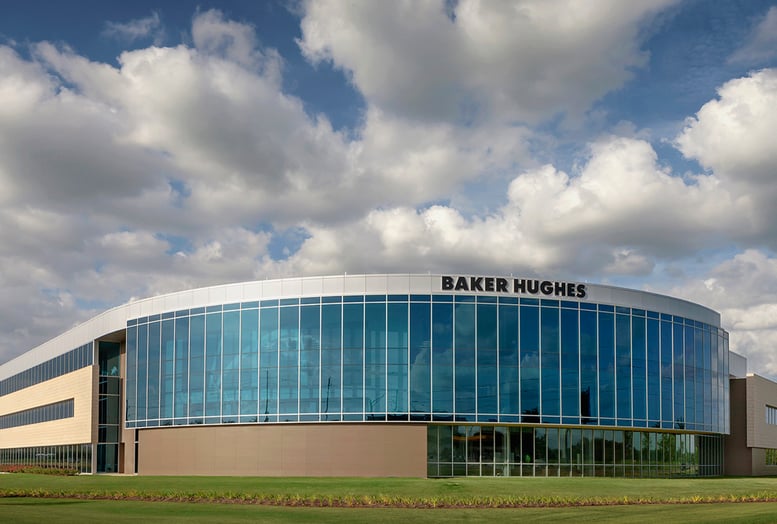“Specifying” glass refers to the step in the building design process in which you or your team designate your architectural glass selections, often with a specific purpose in mind. It’s important to be thorough and precise when it comes to considering available glass options, but where to start may not always be clear. To help make specifying simple, we’ve gathered answers to some common questions about how to specify glass, including what factors you should consider when making glass selections and what resources are available to develop the best possible specifications for your project.
What is “specifying glass,” and when does this take place in the building process?
Usually, specifying glass selections takes place during the design and development planning stages of new construction. Glass often makes up the majority of the curtainwall in today’s buildings, so it’s important to ensure your specification is well suited to your project’s needs. When you’re considering what glass to specify, you should first consider your performance and aesthetic requirements; identifying manufacturers and product numbers can come later. If you’re being precise with your requirements, whether performance or aesthetics, it will narrow your search to ensure your project goals are met.
What are some performance factors to consider when specifying glass?
For many projects, glass performance is an essential consideration when it comes to meeting green building code requirements and achieving a range of sustainability certifications. For information on specific green building codes and certifications, see “Codes and Climate Zones” and "Sustainability Certifications."
 |
 |
|
Solar Heat Gain Coefficient is the measure of solar radiation transmitted through a window.
|
Visible Light Transmittance measures the glass’ ability to facilitate daylighting. |
Some of the most important performance metrics to consider for glass specification are U-value, which measures the glass’s insulating characteristics, and solar heat gain coefficient (SHGC), which measures how well the glass blocks the heat from sunlight. Visible light transmittance (VLT) and exterior reflectance are also factors to consider, though these measurements are often more relevant to the glass selection’s aesthetics. For more information on these performance factors, see “Key Glass Performance Measures.”
What are some aesthetic factors to consider when specifying glass?
Color is the primary consideration when it comes to glass aesthetics. When viewing a lite of clear glass, you may notice its slight green tint, which becomes more pronounced when viewed from an angle and becomes even darker at an increased thickness. Consider specifying low-iron glass products, which offer clearer visuals with less green hue for a truly “clear” look. Learn more in “Ensuring a True Low-Iron Look” and “Designing with Low-Iron Acid-Etched Glass,” which discusses how low-iron glass can be etched with patterns for enhanced visuals and bird safety, which discusses how low-iron glass can be etched with patterns for enhanced visuals and bird safety.

Omni Fort Worth Hotel and 1301 Throckmorton, Omni Residences
Fort Worth, TX
Products: Vistacool® Glass Azuria® Glass + Solarban® 60 Optiblue® Glass (Formerly Solarban® z50 Glass)
Photo Credits: Tom Kessler Photography
Performance-tinted architectural glass products are also available, with many manufacturers offering glasses with blue, green, bronze and gray tints for bold visuals and to help with glare reduction. The darker the tint, the better the glass is at absorbing light and reducing SHGC. You can visit Vitro’s website to browse our selection of tinted glasses.
In addition to the color of the glass, architects should consider the product’s Color Rendering Index (CRI). When it comes to architectural glass, a CRI measurement will indicate how the color of objects behind the glass will be rendered compared to objects under natural daylight. Learn more about the relationship between glass and color in “Color Rendering Index: How Glass Affects Color Rendering.”

Baker Hughes
Houston, TX
Products: Pacifica® Glass, Solarban® 60 Glass, Solarban® 70 Glass, Vistacool® Glass
Photo Credits: Duke Glass, Inc.
Another thing to consider is the reflectivity of your glass selection. Reflective glass has a metallic coating that makes it possible to see out while preventing passersby from seeing in, which helps to preserve privacy during the day. In addition, reflective glass may be used to create a mirrored effect and makes it possible to hide computer wires, vents, fans, HVAC components and other building mechanicals. To learn more, see “The Benefits of Designing with Reflective Glass.”
What role does orientation play in specifying glass?
Orientation can be used to refer to two different glass considerations: surface orientation, or the order and locations in which glass coatings are applied, and building orientation.
Surface orientation relates to whether a low-emissivity (low-e) coating is applied to the second, third or fourth surface of an insulating glass unit (IGU). On the second surface, low-e coatings offer the best solar heat gain performance and lower SHGC values, which is helpful for more southern, warmer climates. On the third surface, low-e coatings allow for more solar heat gain for passive heating, which is helpful for more northern, colder climates. On the fourth surface, applying a low-e coating can dramatically improve U-values for superior insulating performance. To learn more about low-e coatings, see “Optimal Low-E Coating Placement for Double- and Triple-Glazed IGUs,” “How Low-E Glass Works” and “The Science of Low-E Coatings.”
For building orientation, it’s important to consider which cardinal direction your building’s facade will be facing. In North America, Northern-facing facades receive the least amount of heat and light, while Eastern-facing will receive a higher ratio in the morning and Western-facing in the afternoon and evening. You’ll want to consider Southern-facing facades, which generally allow for more heat and light to come in. This means you’ll want to specify glass with a lower SHGC or aesthetic features like a tint or shading to maximize heat reduction – or choose a glass product with a higher SHGC for increased passive heat.

Mundelein High School - Science Addition
Mundelein, Illinois
Products: Solarban® 60 Glass, Solarban® 70 Glass, Solargray® Glass
Photo Credits: Tom Kessler
What resources are available to help architects specify the correct glass for their projects?
Vitro offers many resources for architects specifying glass to help with making your selections. The Vitro GlassFinder™ tool is the best place to start. This tool can help you identify a range of products that meet the criteria for your next design, build a custom list of product options to compare, download product literature and order samples.
We encourage all architects to order free samples of glass products that you may consider for your building project. Additionally, on Vitro’s sample order site, you can access education on how to properly view your sample in a range of conditions to make sure you have an accurate impression of the product.
If you have specific questions or want to talk to an expert, use Vitro’s “Find Your Architectural Rep” tool to find your region’s National Architectural Manager, who can provide glass selection assistance as well as offer glass design support and sustainability expertise.
For more information about Vitro’s selection of architectural glass products, please visit vitroglazings.com/products. For any other glass questions, please contact Vitro Glass or call 1-855-VTRO-GLS (1-855-887-6457).
Kansas City, Missouri
Products: Solarban® 70 Optiblue® Glass (Formerly Solarban® z50 Glass)
Updated on May 16, 2025




